|
|
|
 |
|
|
|
|
|
|
|
Welcome to Spaightwood Galleries, Inc.
120 Main Street, Upton MA 01568-6193; 800-809-3343; email: spaightwood@gmail.com
You can follow us on Facebook at http://www.facebook.com/andrew.weiner.16
and http://www.facebook.com/pages/Spaightwood-Galleries-Inc/122951564441757
Old Master Drawings: 16th-17th-Century Bolognese School Drawings
After long blocks of text, there will be huge open spaces. Please persevere: images and texts will follow.
|
|
|
|
|
|
Tintoretto had a sign in his workshop saying that here could be found "the drawing of Michelangelo and the color of Titian," and it is clearly Titian's color that most 16th-century viewers found overwhelming. Vasari, in his "Life of Titian" (in Part III of The Lives of the Painters, Sculptors, and Architects) reports that Sebastiano de Piombo remarked that "if Titian had gone to Rome and seen the works of Michelangelo, Raphael, and the ancient statues there, and had studied design ("disegno" in Italian combines the meanings of both "drawing" and "design"), he would have produced stupendous things, seeing his skill in coloring, in which he deserves to be called the best master of our day for his imitation of natural tints; and with a foundation of great draughtmanship he would have overtaken the Urbinate [Raphael] and Buonarroto [Michelangelo] (Everyman edition, III: 200-201)." Vasari later confirms Sebastiano's judgment by telling of a visit that he and Michelangelo made to Titian's studio in Rome: "After they had gone, Buonarroti criticized Titian's methods, prasing him a good deal, and saying that he liked his coloring and style, but that it was a pity that good design was not taught at Venice from the first, and that her best painters did not have a better method of study. If this man, he said, were aided by art and design as he is by Nature, especially in copying from life, he would not be surpassed, for he has ability and a charming and vivacious style" (Everyman edition, III: 206-207).
By the late 16th century, this opposition between color and design was no longer seen as defining the two important qualities required for good painting. The Carracci tried to establish a new set of extremes to which they would be the synthesis. Rejecting the "disegno" of Michelangelo and the Mannerists, they strove to marry color and "nature." Or as Bellori put it in his late 17th-century Life of Annibale Carracci Bolognese Painter, "Painting attained men's greatest admiration and appeared to have descended from heaven, when the divine Raphael, with the supreme lineaments of art, increased its beauty to sublime heights, reinstating it in the ancient majesty of all those graces and enriching it with those merits that once rendered it glorious among the Greeks and the Romans. But because things on earth never maintain one same state, and those that have reached the heights must perforce revert again to falling , the art that from Cimabue and Giotto had advanced gradually over the long course of two hundred and fifty years, was soon seen to decline, and from a queen it became lowly and common. And so that blessed age having come to its end, in a short time every one of its forms vanished; and artist, abandoning the study of nature, corrupted art with maniera, by which we mean the fantastic idea, based on artistic practice and not on imitation" (Giovan Pietro Bellori, The Lives of the Modern Painters, Sculptors and Architects (1672), trans. Alice Sedgwick Wohl (Cambridge: Cambridge University Press, 2005), p. 71. Mcihelangelo's design and the style that grew from it, in which each artist tried to find his own particular way of presenting his subject, a style that placed a premium upon originality and "stylishness" has been rejected; the new model strove to combine color (as seen in the paintings of artists like Correggio, Titian, and Veronese) with imitation, now understood as the study of nature, and with "classicism" (Andreas Henning and Scott Schaefer, ed. Captured Emotions: Baroque Painting on Bologna, 1575-1725 [Los Angeles: J. Paul Getty Museum, 2008], p. ix).
Into this transition moment stepped Ludovico Carracci and his two younger cousins, Anniable Carracci (1560-1609) and Agostino Carracci (1557-1602). Although Ludovico trained with Federico Zuccaro in Venice, he came to reject Federico's influence, perhaps under the impetus of Annibale, whom he trained, and Agostino; the three then formed a new Academy, the Academia degli Incamminati (or those who found the way). As Nicholas Turner observes in his lengthy essay on Ludovico, "By the end of the 1590s, Ludovico's position as Bologna's pre-eminent painter had been earned by the consistently high quality and originality of his pictures" (Grove Dictionary of Art 5: 851-56; here at 854). In the painting of the Carracci and their followers, color plays an important role in idealizing and elevating the subjects, but it is hard to judge the importantance of color in drawings, which are mostly monochromatic. However, what is clear even in the drawings is the interaction between human subjects and between human and divine subjects. As Turner observes, "The Carracci's pursuit of a more naturalistic conception of the subject gave drawing an important role, enabling them to confront nature and obtain a more truthful rendering of reality. Ludovico's drawings of the 1580s and 1590s, together with those of his cousins from the same period, show this striving towards a more naturalistic rendering of the human figure" (5: 855). In his working methods, Ludovico often prepared a series of drawings that varied in design, even though they were all for the same work, considering "many possible solutions for a given composition before finally opting for one" (Turner, 5: 855).
|
|
|
|
|
|
|
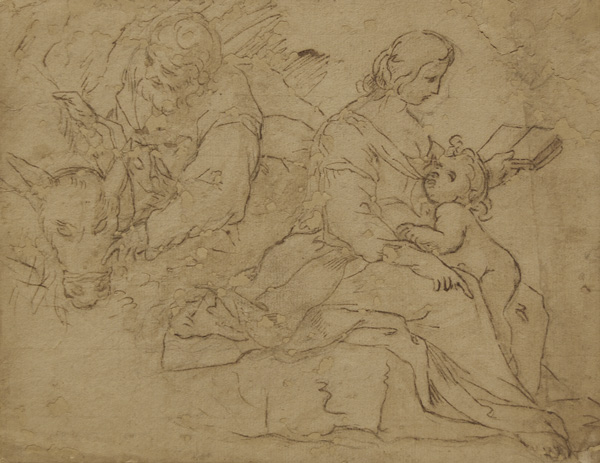 |
|
|
Ludovico Carracci (Bologna, 1555-1619), Rest on the Flight into Egypt. Pen and brown ink drawing on cream laid paper mounted on laid paper; a number of small holes in the paper have been made less unsightly by coloring the backing sheet. (It really isn't as bad to the eye as the photo makes it seem). There is a pencil attribution to Ludovico Carracci on the verso. If one compares the drawing with his engraving and etchings of The Madonna and Child with Angels, the attribution looks completely convincing. Image size: 184x235mm. Price: Please call or email for current pricing information.
This work, and 4 others from our inventory, will be included in a show at the Haggerty Museum of Art at Marquette University in Milwaukee WI and will then travel to a second museum exhibition in 2013. Any purchase will be contingent upon the purchaser's willingness to accept delivery in 2014.
|
|
|
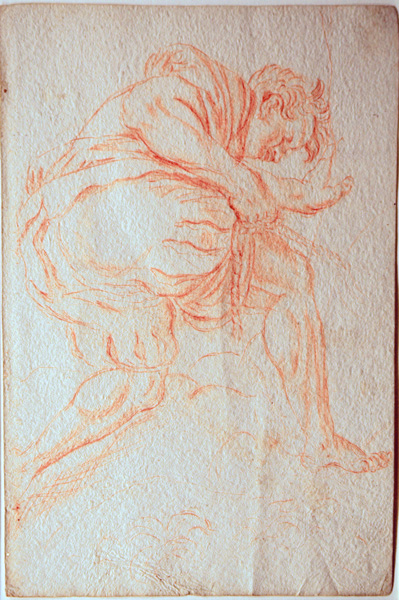 |
|
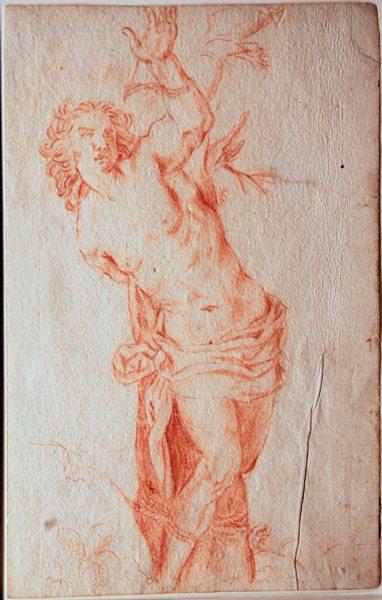 |
|
These two drawings are based upon an engraving by Aegidius Sadeler after Jacopo Palma il Giovane (Venice, 1548-1628), Torturer. Red chalk on heavy cream laid paper, c. 1580. A man, is tugging on a rope in his right hand, apparently increasing the tension. In the accompanying drawing, we see that the object of the tightening is St. Sebastian, tied to a tree and bound by the same rope. The drawing itself has been attributed to Annibale Carracci on the basis of style. Image size: 208x138mm. Sold only as a pair: Please call or email for current pricing information.
|
|
These two drawings are based upon an engraving by Aegidius Sadeler after Jacopo Palma il Giovane (Venice, 1548-1628), St. Sebastian. Red chalk on heavy cream laid paper, c. 1580. In this drawing, we see St. Sebastian, bound by the same rope the torturer was using.The drawing itself has been attributed to Annibale Carracci on the basis of style. Image size: 208x132mm. Sold only as a pair: Please call or email for current pricing information.
|
|
|
|
|
|
|
|
|
|
|
From their studio, the Italian brothers Annibale (1560-1609) and Agostino Carracci (1557-1602), with their cousin Ludovico (1555-1619), produced art that greatly influenced European painting and drawing of the 17th and 18th centuries. Through their study of nature and the art of Michelangelo, Raphael, and Correggio, they rejected the mannered approaches of contemporaries and laid the foundation for the development of Baroque art. Though many drawings were studies in preparation for painting commissions, they drew everything they observed more extensively than previous generations of artists: people, animals, landscapes, and everyday life scenes. They studied these drawings and students in the Academy they founded studied them. Their drawings influenced the great English architect, Inigo Jones, and Carracci drawings entered England's Royal Collection as early as the 1700s.
As Diane De Grazia put it in the introduction to the section on Annibale Carracci in Corregio and His Legacy, "Considered the genius of the Carracci family, Annibale was certainly the most inventive as well. In the past thirty years he has finally been recognized for his achievements. There are now several monographs on the artist, and the current argument among scholars concerns the extent of his genius: was it innate or was he also a learned man? Annibale probably trained as a painter under his elder cousin Lodovico and he learned printmaking from his brother Agostino. He traveled (perhaps as early as 1580) to Venice and Parma, where he came under the influence of Correggio, which along with that of Barocci is apparent in his early drawings and in his work in the Palazzo Fava frescoes. Later in the 1580s he visited Venice, and his work in the late 1580s, such as the Madonna of Saint Matthew in Dresden, shows the impact of Titian in both color and composition. After working with Loodovico and Agostino in the early1590s on the Palazzo Magnani frescoes and on other joint projects, he was called to Rome in 1594. Except for a brief trip back to Bologna in 1595 and one to Naples in 1609, he remained there until his death in 1609. His Roman masterpieces (in fresco) are the Camerino Farnese (1595-1597) and the Galeria Farnese (1597-1600) in the Palazzo Farnese. In the Camerino the spirit of Correggio was sustained, but in the Galeria Raphael and Michelangelo replaced Annibale's earlier hero as a source of inspiration. This might suggest that the label of eclectic pinned on Annibale is a correct one. However, like most artists Annibale was influenced by a variety of sources, and his genius lay in his skill at adapting these disparate styles to his own original personality. Annibale's lasting contribution was not only his renewal of Renaissance sources, but his new appreciation of nature. The combination of forms based on nature and on an artistic ideal made Annibale the inspiration for Roman painters of the entire seventeenth century" (364).
Annibale also treats Apollo in a drawing in the Royal Colection at Windsor Castler. See catalogue number 312: Apollo receiving the lyre from Mercury in R. Wittkower, The Drawings of the Carracci in the Collection of Her Majesty the Queen at Windsor Castle (London: Phaidon Press, 1952), p. 140.
Selected Bibliographty: Daniele Benati, Diane De Grazia, Gail Feigenbaum, Kate Ganz, Catherine Loisel Legrand, et al. The Drawings of Annibale Carracci (Washington: National Gallery of Art, 1999); Diane DeGrazia Bohlin, Prints and related drawings by the Carracci Family. A catalogue raisonne (Washington DC: National Gallery of Art, 2000); J. P. Cooney, ed. L'Opera Completa di Annibale Carracci (Milan: Rizzoli Editore, 1976); Carl Goldstein, Visual Fact over Verbal Fiction. A Study of the Carracci and the Criticism, Theory, & Practice of Art in Renaissance & Baroque Italy (Cambridge: Cambridge University Press 1990); Diane De Grazia, Corregio and His Legacy: Sixteenth-Century Emilian Drawings (Washington: National Gallery of Art, 1984); Donald Posner, Annibale Carracci: A Study in the Reform of Italian Painting around 1590, 2 v ols. (NY: Phaidon, 1971); Clare Robertson and Catherine Whistler, Drawings by the Carracci from British Collections (Oxford: Ashmolean Museum, 1996); R. Wittkower, The Drawings of the Carracci in the Collection of Her Majesty the Queen at Windsor Castle (London: Phaidon Press, 1952)
|
|
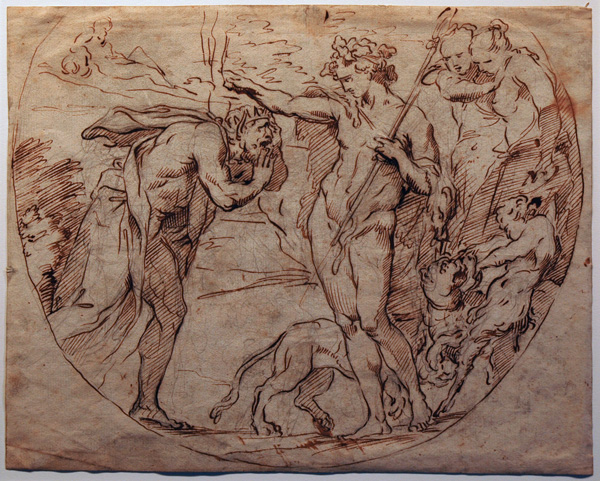 |
|
|
Annibale Carracci (Italian, 1560-1609), attributed, Apollo giving ass's ears to King Midas for prederring Pan's music to that of Apollo in a singing contest. Pen and brown ink and pencil on cream laid paper, c. 1603-1604. Annibale did drawings of Pan c. 1597-98 (National Gallery 2000 n. 49), and a number of other drawings of Apollo c. 1603-1604 for the Farnese Gallery in Rome. Image size: 270x335mm. Price: SOLD.
For another drawing by Annibale Carraci and selected bibliography , please click here.
|
|
|
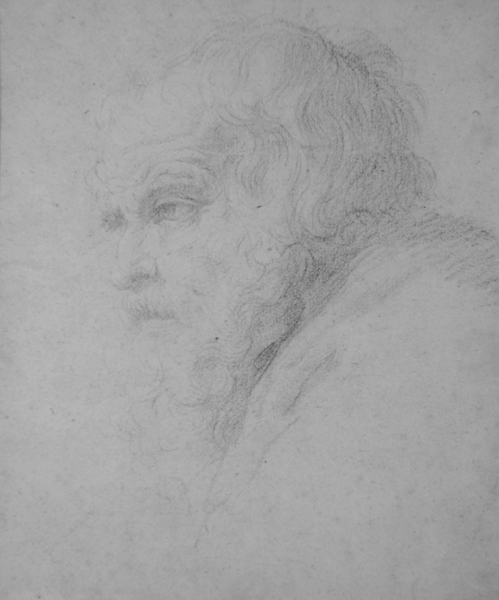 |
|
|
|
Il Domenichino (Domenico Zampieri, 1581-1641), Head of an old man looking to the left. Black chalk stumped and whitened with white chalk on heavy grayish-brown laid paper. On the verso is a fragment of another drawing showing a dragon attacking on horse and rider) while on the right a woman watches (see below), probably a study for a St. George battling the dragon. This study presents a type common in Domenichino's works: an old man, with a long, curly beard, an aquiline nose, and a very high forehead. See Spears, vol. 2, plates 3 (St. Jerome, 1602), 10 (Joseph of Arimathea, 1602), 34-35 (St. Joseph, 1604-06), 46 (St. Jerome, 1606-08), 73 & 76 (St. Niles, 1608-1610), 143 (St. Jerome, 1614), and 197 (1618-19). The study for the Last Communion of St. Jerome (pl. 143) is perhaps the closest to ours in overall feel, but the old man is more an ideal type than a study of a specific model. Image size: 392x248mm. Price: Please call or email for current pricing information.
For more drawings by Domenichino and selected bibliography , please click here.
|
|
|
|
|
|
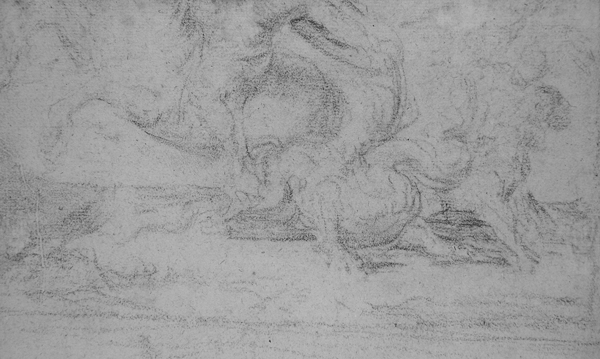 |
|
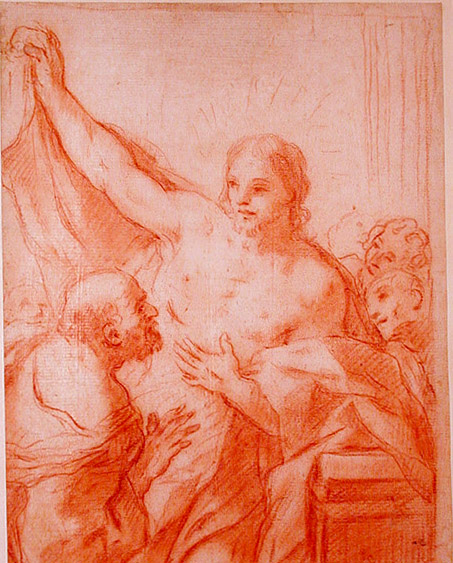 |
|
|
|
Guercino, attributed, Doubting Thomas. Red chalk drawing on laid paper with no watermark, c. 1621. Stamped with the collector's mark of J. Auldjo (Lugt 48). A previous owner has noted "Guercino" as the author of this drawing, in which St. Peter watches as St. Thomas reaches around from behind to insert his left hand into the wound in Christ's side at Jesus' command so that he might not perish through his unbelief. For a 1621 oil painting of the same subject, see David M. Stone, Guercino: cataloge completo die dipinti n. 73, p. 95 or Stone, Guercino: Master Draftsman, fig. 10a, p. 24, where it is accompanied by one of the preparatory drawings, p. 25. The painting, like our drawing, shows Christ, St. Thomas, St. Peter, and additional disciples (in this case, 2). The drawing in Stone, which differs significantly from the painting, shows only Christ and St. Thomas. Image size: 264x204mm. Price: Please call or email for current pricing information 500.
In July 2010, one of Guercino's paintings sold at Chrisitie's London for Please call or email for current pricing information,240; the high price for one of his drawings at auction is Please call or email for current pricing information (Sotheby's, London, July 2006), and since 1990, 15 of his drawings have sold at auction for over Please call or email for current pricing information.
|
|
|
|
|
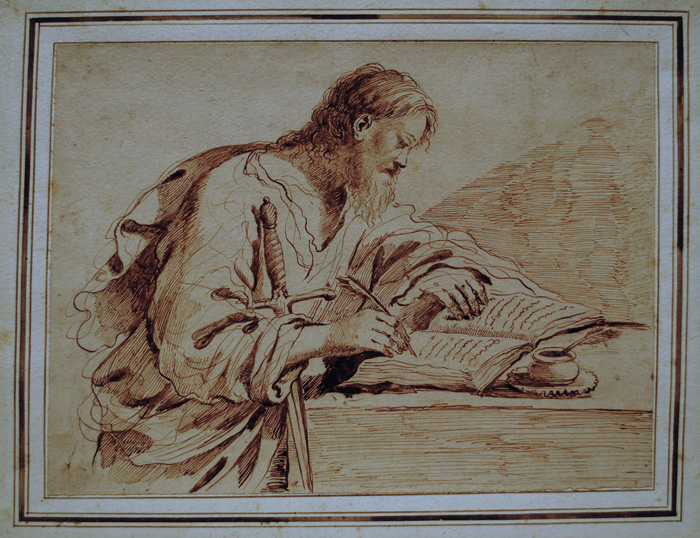 |
|
|
|
Guercino, attributed, St. Paul. Brown chalk drawing on laid paper with no watermark laid down upon a heavy sheet of laid paper with an irregularly-drawn decorated border, perhaps for mounting in an album. St. Paul sits at a desk, writing one of his epistles, the sword of his martyrdom leaning against the table upon which he works; an inkpot sits by his book within easy reach. The same sword is visible in Guercino's large 1644 oil painting of St. Paul in the Cuppini Collection in Verona (see David M. Stone, Guercino: cataloge completo die dipinti [Cantini 1991], n. 188 on p. 203). The elaborately-feathered quill pen that St. Paul uses seems to be, if not the same then at least very similar, although the treatment of the saint is different (in the painting he faces to the left at a 45 degree angle and is much more heavily bearded. Image size: 208x279mm. Price: Please call or email for current pricing information.
For more drawings by Guercino and selected bibliography , please click here.
|
|
|
|
|
 |
|
|
Giovanni Lanfranco (aka Cavaliere Giovanni Di Stefano, Parma, 1581-1647 Rome), An Angel seen from behind. Black chalk with white chalk heightening. A very assured drawing on grayish light blue laid paper. Image size: 230x245mm. Price: Please call or email for current pricing information.
As a boy Lanfranro was a page at Piacenza in the service of Count Orazio Scotti, who noticed his talent for drawing and apprenticed him to Agostino Carracci in Parma, with whom he remained for some years; before he was sixteen he had painted a picture of the Virgin and Saints, which was so much admired that it was considered worthy of being placed in the church of Sant' Agostino at Piacenza. On the death of Agostino in 1602, Lanfranco went to Rome and assisted Annibale Carracci in decorative work in the Farnese Gallery, in the Vatican, and in various Roman churches. By 1604-05, his drawings already show "the delicate forms, fluid movement and the chiaroscuro modelling that distinguish him for Annibale's other pupils" (see the long article by Erich Schleier in the Grove Dictionary of Art, 18: 730-37; here at 730). According to Schleier, even his early works show his "astonishing artistic independence from Annibable and his pupils, despite his geneeral orientation towards Annibale's style" (p. 730). He spent 1610-12 in Piacenza, where he suddenly received . . . many demands for paintings for churches; his reputation may have been enhanced by his having worked with Annibale in Rome. He . . . came increasingly, if briefly under the influence of Ludovico Carracci and Bartholomeo Schedoni" (p. 731). He returned to Rome in 1612, where he remained until 1620. From 1612 to 1614, the dominant artists ini Rome were still Reni, Domenichino, Albani and Domenico Passignano, and Lanfranco clearly needed some time to re-establish himself" (p. 731). In two ceiling frescoes in the Palazzo Mattei (1615), "Lanfranco attained a new elegance and explored subtle contre-jour effects and iridescent colors" (732); he also received many public commissions from Rome and elsewhereas well asa private commissions for paintings of Old Testament subjects" (732). By 1620, he had achieved a reputation as the most "Progressive painter in Rome" (p. 732) and soon moved beyond his "elegant Caravaggism" and "created a new, vigorous style" (p. 732), bringing "a new breadth and dynamism to the figures. . . . His style between 1620 and 1625 may be described as proto-Baroque" (732). In this new style, "diagonals are dominant, and the resulting tension is quite different from the classicism of Annibale Carracci, Domenichino and, later Cortona, whose works are composed in layers parallel to the picture plane" (p. 733). For additional work on Bolognese Painting, see Andreas Henning and Scott Schaefer, ed. Baroque Painting in Bologna, 1575-1725 (Los Angeles: J. Paul Gettu Museum, 2008); for studies of Lanfranco's drawings, see Erich Schleier, ed. Disegni de Giovanni Lanfranco (Florence: Leo S. Olschki, 1983) and Erich Schleier, Zeichnungen des Giovanni Lanfranco, Dello Stilo naturale (Dusseldorf: Deutscher Kunstverlag / Sammlung der Kunstakademie Düsseldorf, 2006).
|
|
|
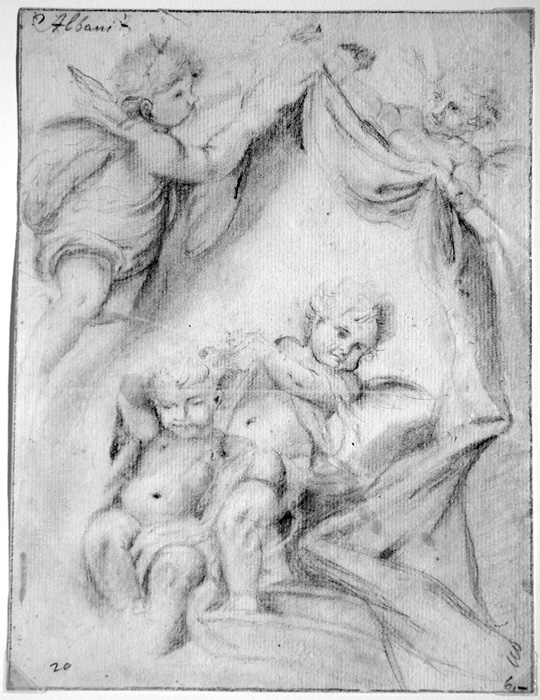 |
|
|
|
Francesco Albani (Bologna, 1578–1660), Studies of Cherubs Holding a Drapery. Black chalk on cream laid paper, early-mid 17th century. Albani's paintings often feature putti or cherubs like these. "Albani" inscribed upper left; old prices lower right (6-) and lower left (20) indicate that they were on the market a very long time ago. Image size: 278x210mm. Price: Please call or email for current pricing information.
For drawing on verso, see below.
|
|
|
|
|
|
 |
|
Francesco Albani (Bologna, 1578–1660), A Monk offering communion to the sick and the crippled. Black chalk on cream laid paper, early-mid 17th century. Image size: 145x150mm Price: Please call or email for current pricing information.
For more drawings by Albani and selected bibliography , please click here.
|
|
|
|
|
|
|
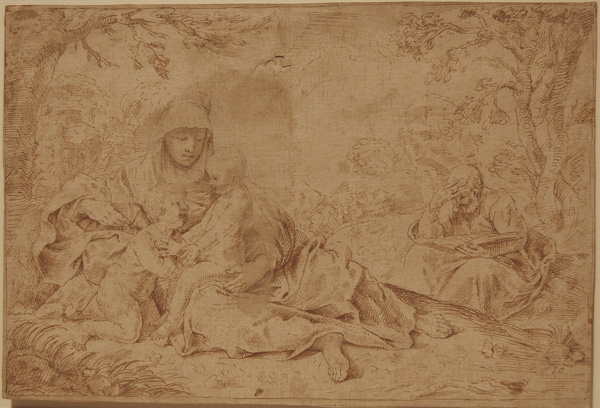 |
|
|
Simoni Cantarini (Pesaro, 1612-1648), Attributed, The Holy Family with St. John the Baptist. Pen and brown ink on cream laid paper. Initialed in ink lower right. Fleur-de-lys watermark. For Cantarini's etching of the same subject, see The Illustrated Bartsch 42: Italian Masters of the Seventeenth Century p. 78, n. 11. Additional studies for the etching can be seen in the Pinacoteca di Brera, Milan (inv. n. 124) and the Louvre (inv. n. 7079 bis). Image size: 202x301mm. Price: Please call or email for current pricing information.
This work, and 4 others from our inventory, will be included in a show at the Haggerty Museum of Art at Marquette University in Milwaukee WI and will then travel to a second museum exhibition in 2013. Any purchase will be contingent upon the purchaser's willingness to accept delivery in 2014.
|
|
|
 |
|
|
|
Simoni Cantarini (Pesaro, 1612-1648), Attributed, Saint Apollonia. Red chalk drawing on cream laid paper laid down on heavy laid paper with a hand-drawn decorative border about the drawing. Inscribed "Simon da Pesaro" in ink lower center recto and "Apollonia" on the backing sheet beneath the drawing. According to an inscription on the bottom of the decorative mount and the mat verso, it was formerly owned by John Skippe. Image size: 270x173mm. Price: Please call or email for current pricing information.
For more drawings by Cantarini and selected bibliography , please click here.
|
|
|
|
|
|
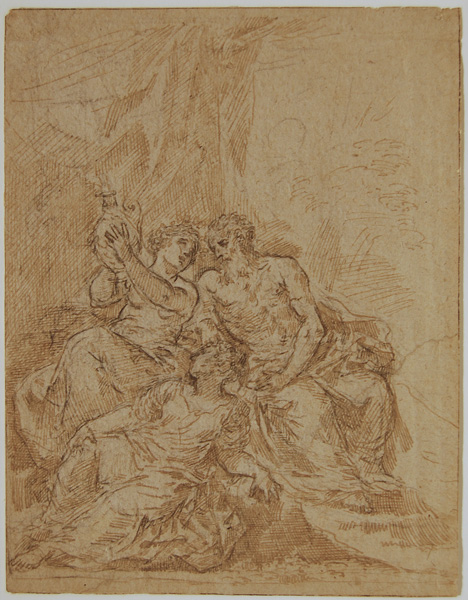 |
|
Bolognese School (early-mid 17th century), Lot and his Daughters. Pen and brown ink on cream laid paper mounted on laid paper. At Abraham's urging, God selected Lot (Abraham's nephew) and his family as the only just people in Sodom to be saved. Although he warned them not to look back at the destruction of Sodom as they fled, Lot's wife did and was turned into a pillar of salt. Later that night, Lot's daughters, fearing that they were the only ones left alive in the world, got Lot drunk and then slept with him in order to repopulate the earth. This nicely-ironic story, like many others, is a reminder that one ought not to trust to his or her own virtue but to God's mercy. It became a more popular subject after the Reformation and the Counter-Reformation. Image size: 236x183mm. Price: Please call or email for current pricing information.
|
|
|
|
|
|
|
|
|
We present here a collection of 17th-century Italian drawings, done either in red or black chalk, having at least one thing in common: all were at one point in the same collection, each having had tabs of black paper glued to the verso to allow mounting them in an album. None of the pieces, alas, have a collector's stamp, so we do not know when or where or who, but they do offer an opportunity to think about why people collect the works of art that they collect. Nine of the pieces are in red chalk. Three of this group appear to be studies for a St. Sebastian (one of the three shows the figure with an arrow embedded in his breast), three are busts of adults, two women and an elderly man, three are children, without wings, so probably not Cupids, but more likely to be Cherubs (though one, having nothing of the divine about him, may be a study of a real child). There are also two studies of boys or young men, done in black chalk; at least one of these appears to date from the 18th century, all of the others seem, on stylistic grounds, to have been created in the 17th century, probably an artist or several artists familiar with the artists of the Bolognese school, especially the Carracci and Guido Reni. When we have some time, we will be researching Italian artists of the 17th century; as we learn more, the prices will probably rise, perhaps significantly so should they appear to be related to works by important artists; extravagantly so should they turn out to be by major artists. For the moment, however, we offer them at introductory prices appropriate to our estimation of their present value for enjoying and understanding the place of drawings in the hearts of earlier collectors.
|
|
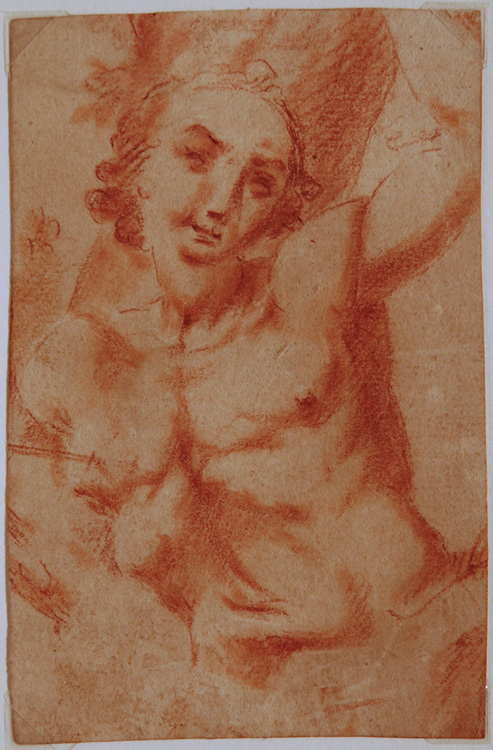 |
|
|
|
|
|
|
|
School of the Carracci, 17th-century, Study for a St. Sebastian. Red chalk drawing on heavy cream laid paper with no watermark. The arrow in his right breast suggests that this is a study for a St. Sebastian; the uneven trimming suggests that it might once have been a part of a larger composition and may signal that this collection was put together for the assistants in the workshop of an artist successful enough that he needed assistants. Image size: 129x85 mm. Price: Please call or email for current pricing information.
On my 24-inch monitor, this is about life-size; on my 13-inch Macbook, it is 115mm in height.
|
|
|
|
|
|
 |
|
|
|
School of the Carracci, 17th-century, Study for a St. Sebastian II. Red chalk drawing on heavy cream laid paper with no watermark. For some suggestive similarities to this composition, see L'opera completa di Guido Reni (Rizzoli, 1971), pl. 63-64). The uneven trimming suggests that it might once have been a part of a larger composition and may signal that this collection was put together for the assistants in the workshop of an artist successful enough that he needed assistants. Image size: 114x82 mm. Price: Please call or email for current pricing information.
On my 24-inch monitor, this is about life-size.
|
|
|
|
|
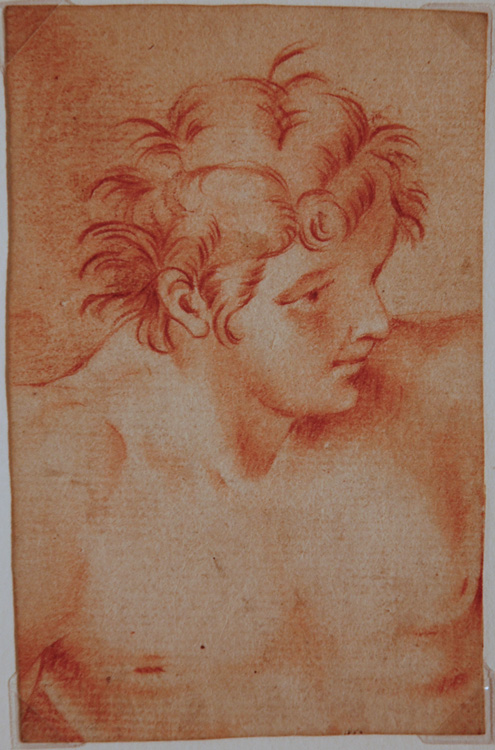 |
|
School of the Carracci, 17th-century, Study for a St. Sebastian III. Red chalk drawing on heavy cream laid paper with no watermark. The uneven trimming suggests that it might once have been a part of a larger composition and may signal that this collection was put together for the assistants in the workshop of an artist successful enough that he needed assistants. Image size: 116x74 mm. Price: Please call or email for current pricing information.
On my 24-inch monitor, this is about life-size.
|
|
|
|
|
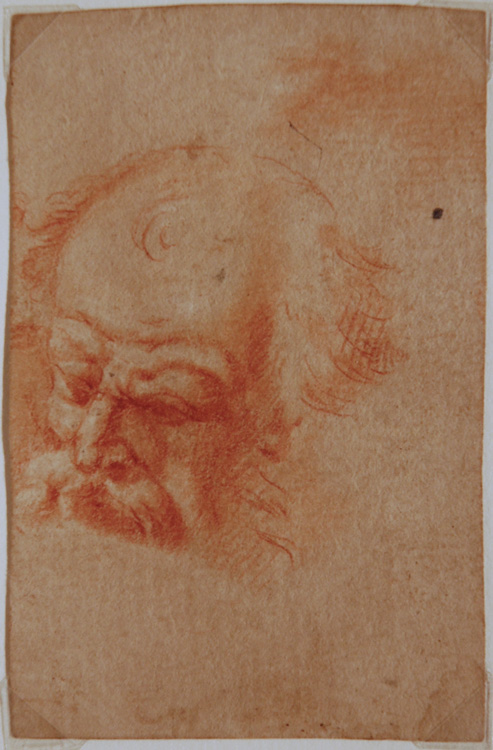 |
|
School of the Carracci, 17th-century, Study of an old man turned to the right. Red chalk drawing on heavy cream laid paper with no watermark. A beautiful study of the head of an old man, with just a few hairs left in the center of his head; like these reminders of his vanished hair, the uneven trimming of the paper suggests that it might once have been a part of a larger composition and may signal that this collection was put together for the assistants in the workshop of an artist successful enough that he needed assistants. Image size: 108x74 mm. Price: Please call or email for current pricing information.
On my 24-inch monitor, this is about life-size.
|
|
|
|
|
|
|
|
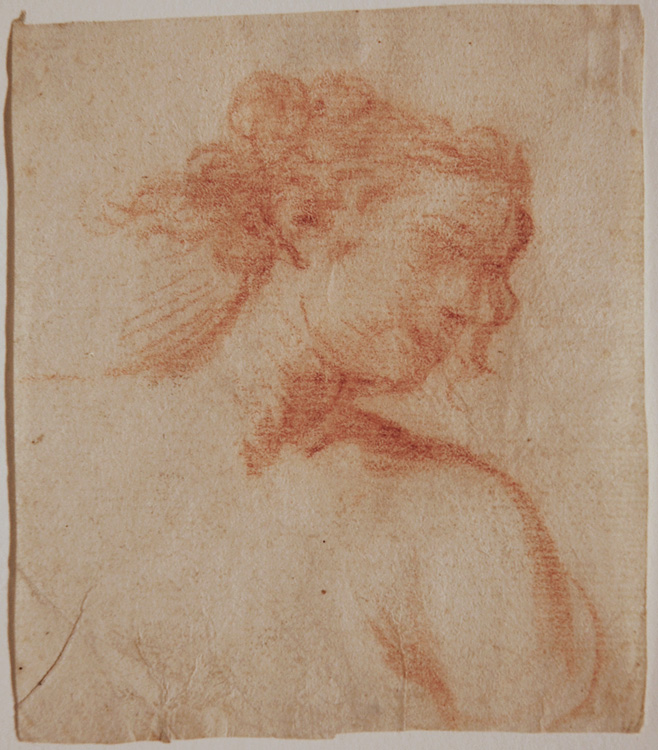 |
|
School of the Carracci, 17th-century, Study of a young woman turned to the left. Red chalk drawing on heavy cream laid paper with no watermark. A study of the head of a beautiful young woman, caught in the act of turning to the left. For some suggestive similarities to this composition, see Annibale's Head of a young girl looking downwards in Drawings by the Carracci from British Collections (Ashmolean Museum, 1996), p. 104). The uneven trimming of the paper suggests that it might once have been a part of a larger composition and may signal that this collection was put together for the assistants in the workshop of an artist successful enough that he needed assistants. Image size: 106x92 mm. Price: Please call or email for current pricing information.
On my 24-inch monitor, this is about life-size.
|
|
|
|
|
|
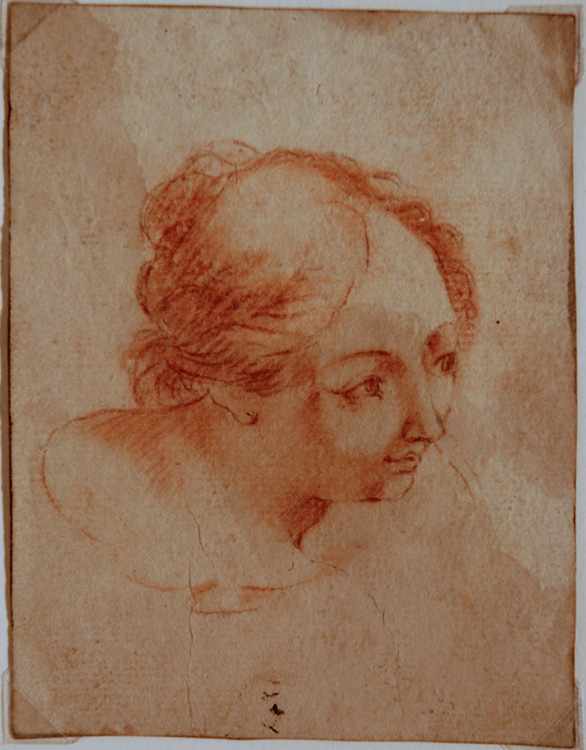 |
|
School of the Carracci, 17th-century, Study of a young woman turned to the left II. Red chalk drawing on heavy cream laid paper with no watermark. A study of the head of a beautiful young woman. The uneven trimming of the paper suggests that it might once have been a part of a larger composition and may signal that this collection was put together for the assistants in the workshop of an artist successful enough that he needed assistants. Image size: 113x86 mm. Price: SOLD.
On my 24-inch monitor, this is about life-size.
|
|
|
|
|
|
|
 |
|
|
School of the Carracci, 17th-century, Study of a Cherub. Red chalk drawing on heavy cream laid paper with no watermark. A study of the head and shoulders of a Cherub (it strikes us as too adult to be a little boy). Although these figures do not seem capable of any action, we might remember Macbeth's musings (I.vii.21-25) and the consequences of murdering King Duncan:
And pity, like a naked new-born babe,
Striding the blast, or heaven's cherubin, horsed
Upon the sightless couriers of the air,
Shall blow the horrid deed in every eye
That tears shall drown the wind.
The uneven trimming of the paper suggests that it might once have been a part of a larger composition and may signal that this collection was put together for the assistants in the workshop of an artist successful enough that he needed assistants. Image size: 120x80 mm. Price: Please call or email for current pricing information.
On my 24-inch monitor, this is about life-size.
|
|
|
|
|
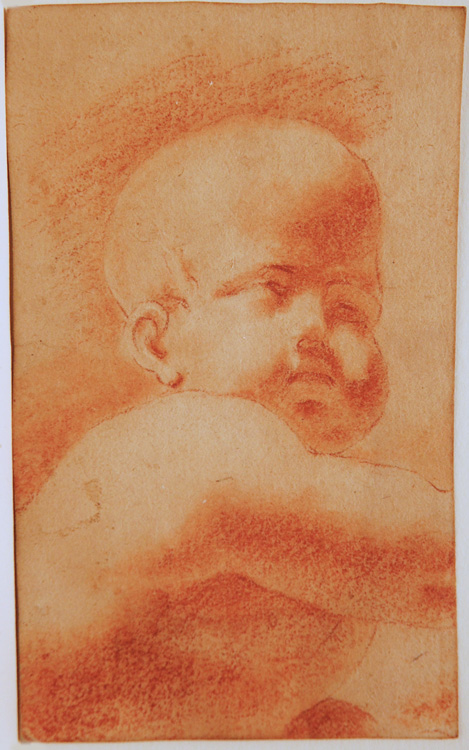 |
|
|
School of the Carracci, 17th-century, Study of a Cherub II. Red chalk drawing on heavy cream laid paper with no watermark. A study of the head and shoulders of a Cherub or a little boy, though it strikes us as too adult to be a little boy (see comment above). The uneven trimming of the paper suggests that it might once have been a part of a larger composition and may signal that this collection was put together for the assistants in the workshop of an artist successful enough that he needed assistants. Image size: 111x65 mm. Price: Please call or email for current pricing information.
On my 24-inch monitor, this is about life-size.
|
|
|
|
|
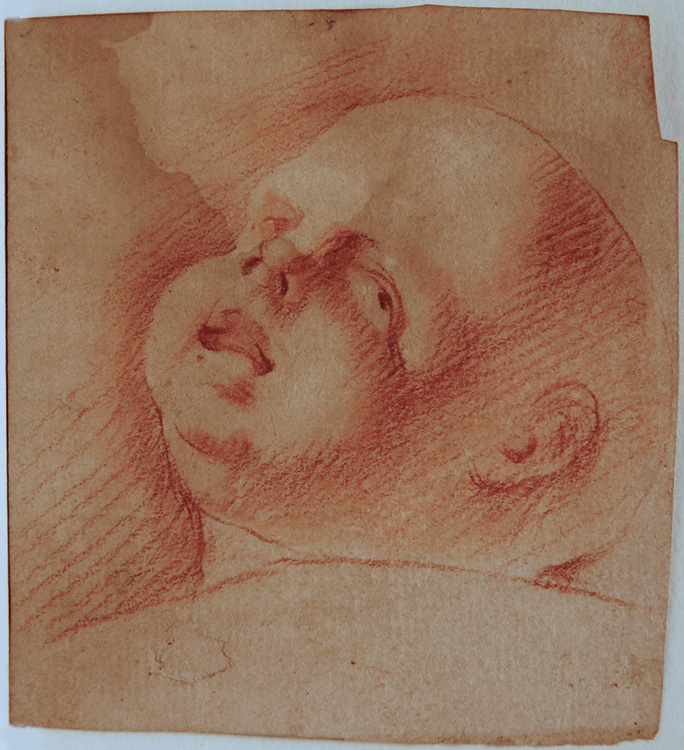 |
|
School of the Carracci, 17th-century, Study of a baby looking to the left. Red chalk drawing on heavy cream laid paper with no watermark. A study of the head and shoulders of a Cherub or a nursing baby, it strikes us as too infantile to be a Cherub. For some suggestive similarities to this composition, see the child in Ludovico's Virgin and Child in Drawings by the Carracci from British Collections (Ashmolean Museum, 1996), p. 50). The uneven trimming of the paper suggests that it might once have been a part of a larger composition and may signal that this collection was put together for the assistants in the workshop of an artist successful enough that he needed assistants. Image size: 86x80 mm. Price: Please call or email for current pricing information.
On my 24-inch monitor, this is about life-size.
|
|
|
|
|
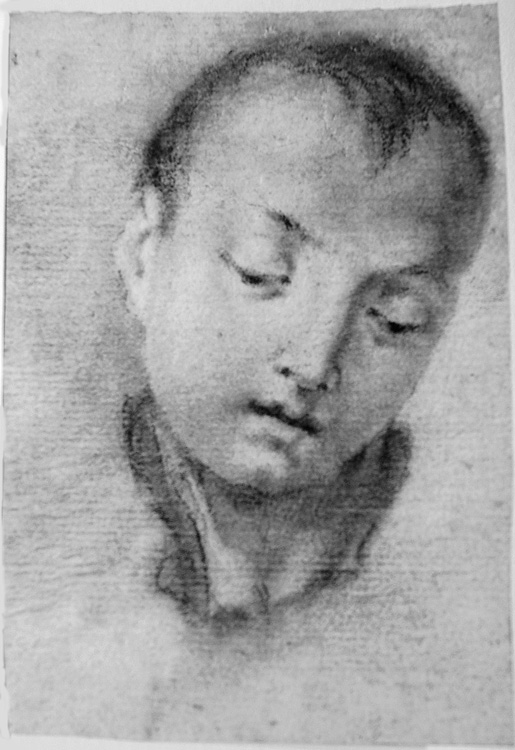 |
|
School of the Carracci, 17th-century, Study of a Boy. Black chalk drawing on heavy cream laid paper with no watermark. For some suggestive similarities to this composition, see Annibale's study of a hunchback boy in Drawings by the Carracci from British Collections (Ashmolean Museum, 1996), p. 107). The uneven trimming of the paper suggests that it might once have been a part of a larger composition and may signal that this collection was put together for the assistants in the workshop of an artist successful enough that he needed assistants. Image size: 120x85 mm. Price: Please call or email for current pricing information.
On my 24-inch monitor, this is about life-size.
|
|
|
|
|
|
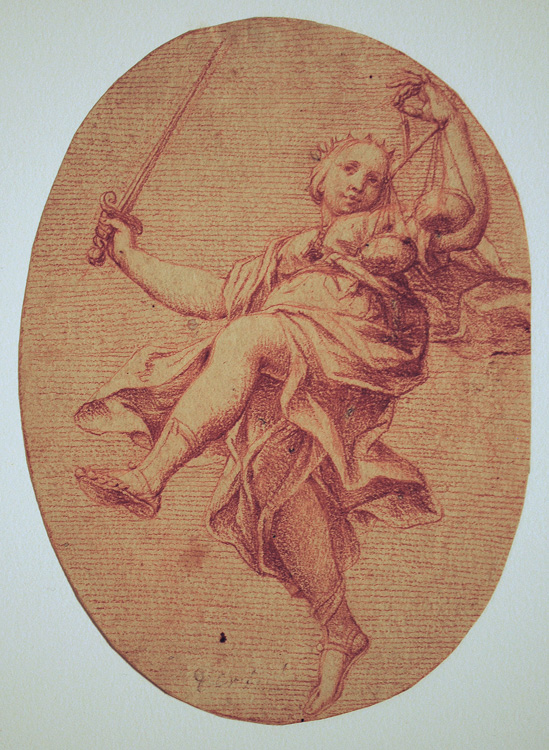 |
|
Giuseppe Maria Crespi (Bologna, 1665-1747), Justice Red chalk on cream laid paper. This very finished-looking drawing offers the low perspective of a viewer gazing on a ceiling painting or one for a high wall. There is also an "Allegorical Figure of Good Government" on the verso. There are a number of prints after Crespi, though there is no print associated with either of these drawings. Following the publication of a study and catalogue raisonne of his works (Mira Pajes Merriman, Giuseppe Maria Crespi (lo Spagnolo) [Rizzoli, 1980]) he was featured in a show at the Kimbell Art Museum in Fort Worth that occasioned a fascinating accompanying monograph by John T. Spike, Giuseppe Maria Crespi and the Emergence of Genre Painting in Italy (1986). Other retrospectives followed in short order, including Andrea Emiliani and A. B. Rave, Giuseppe Maria Crespi 1665-1727 (Bologna: Nuova Alfa, 1990; this show also travelled to Stuttgart, Germany); Elvio Mich, ed, Giuseppe Maria Crespi ed altri Maestri Bolognesi nelle Collezioni di Castel Thun. Il Ciclo di Ercole dalla Quadreria di Francesco Ghisilieri (Trento: Castello del Buonconsiglio, 1998); see also Michael Liebmann, Giuseppe Maria Crespi. Mit einem Text von Luigi Crespi (Dresden: Verlag der Kunst, 1976). For Crespi's drawings, see Master Drawings 27: 3 (1989). Image size: 185x133mm. Price: Please call or email for current pricing information.
|
|
|
Spaightwood Galleries, Inc.
To purchase, call us at 1-800-809-3343 (1-508-529-2511 in Upton MA & vicinity) or send an email to spaightwood@gmail.com.
We accept AmericanExpress, DiscoverCard, MasterCard, and Visa.
We also accept wire transfers and paypal.
For directions and visiting information, please call. We are, of course, always available over the web and by telephone (see above for contact information). Click the following for links to past shows and artists. For a visual tour of the gallery, please click here. For information about Andy Weiner and Sonja Hansard-Weiner, please click here. For a list of special offers currently available, see Specials.
All works are sold with an unconditional guarantee of authenticity (as described in our website listing).
Go back to the top of this page.
Visiting hours: Saturday 10:00 am to 5:00 pm and Sunday noon to 6:00 pm and other times by arrangement.
Please call to confirm your visit. Browsers and guests are welcome.
|
|
|
|
|
|
|
|
|
|
|
|
|
|
|
|
|
|
|
|
|
|
|
|
|
|
|
|
|
|
|
|
|
|
|
|
|
|
|
|
|
|
|
|
|
|
|
|
|
|
|
|
|
|
|
|
|
|
|
|
|
|
|
|
|
|
|
|
|
|
|
|
|
|
|
|
























